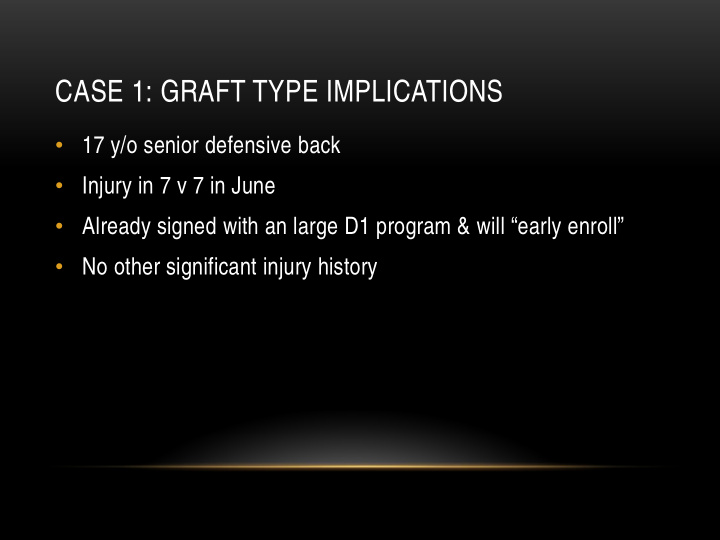



CASE 1: GRAFT TYPE IMPLICATIONS • 17 y/o senior defensive back • Injury in 7 v 7 in June • Already signed with an large D1 program & will “early enroll” • No other significant injury history
IMAGING
MRI
BONE BRUISING
HOW DOES GRAFT CHOICE FOR THIS ATHLETE IMPACT YOUR REHABILITATION PROGRAM? Diagnosis • ACL rupture, no meniscal tear, no articular cartilage defect at time of surgery What really happened….. • BTB- aggressive patellar/fat pad mobilization • WB’ing limited to extension with crutches for 6 weeks (persistent effusion & slow return to quad) • Passed RTS testing at 28 weeks 12/1) will begin return to sport progression over next 2 months. • Goal is participation in Spring Football practice
ACL Reconstruction in a Skeletally Immature Male: Modifications to Traditional Reconstruction and Rehabilitation Mark V. Paterno PT, PhD, SCS, ATC Coordinator of Orthopaedic and Sports Physical Therapy Sports Medicine Biodynamics Center Division of Occupational Therapy and Physical Therapy Cincinnati Children’s Hospital Medical Center Assistant Professor, Department of Pediatrics University of Cincinnati College of Medicine Cincinnati, OH
Initial Presentation History: • 9 y/o skeletally immature male suffered a contact, hyperextension injury on 8/15/2006 during a football game • Current complaints of repeated giving way with daily activities • Enters clinic with a functional performance brace and family is “considering surgical options”
Initial Presentation Physical Exam: ROM: 0-120 MMT : Knee extension and flexion 4/5 Effusion: 1 cm in suprapatellar region Special Testing: Positive Lachman exam, positive pivot shift exam, Negative meniscal testing KT2000: Increased AP translation of 5 mm Gait: Ambulated with a flexed knee gait pattern
Initial Presentation Chief Complaints: – Giving way with activity – Mild effusion in anterior knee – Mild discomfort with activity Patient Goals: Resume football as soon as possible
Pre-operative MRI
Bone Age Determination Sex: Male Chronologic Age: 9 years, 6 months (114 months) Estimated Bone Age: 9 years (108 months)
Pre-operative Treatment Plan 1. Address current impairments: • Decreased functional ROM/altered gait • Manage effusion • Address strength deficits • Modify home activity in brace Patient was seen in clinic 1 x/week x 3 weeks to address these impairments. Surgery was scheduled for 11/4/2006
Surgical Plan What is the ideal surgical plan for this skeletally immature patient?
Surgical Procedure: Modified Transepiphyeal ACL Reconstruction
Post Operative Radiograph
Post Operative MRI
ACLR in a 73 y/o Skier John Cavanaugh PT MEd ATC SCS RESERVATION #:774936759
G.L. Patient is a 73 y/o criminal defense attorney 1 St injury left knee getting his skis tangled with his wife’s skis while getting off a chair lift 12/23/15 in Aspen MRI (+) ACL tear, Proximal MCL sprain, LMT, Contusion Post / Lat Tibial Plateau Pre-Op PT x 4 weeks O-130 ROM Normal Gait Ascend 8” Descend 6” steps ACLR (Achilles Tendon Allogarft) / PLM / Fat pad excision 2/3/16 18
G.L. Post-Op WBAT, Brace Locked @ 0 AAROM, Quad Re-ed, GT Aquaciser, CKC Ex, Patella Mobilization, Balance Normal Gait @ 4 weeks Ascend Stairs @ 6 weeks Squats, FSU, Retro TM Full ROM @ 11 weeks 19
G.L. Descend Stairs (8”) @ 14 weeks Running (AlterG) 15 weeks, Treadmill 18 weeks Plyometric / Agility Exercises Return to Tennis (Doubles) @ 22 weeks Singles Tennis @ 30 weeks Return to skiing 12/1/17 10 months Isokinetic Test @ 10 months – -13.5 % Quad deficit at 180 Degrees/sec 20
Recommend
More recommend